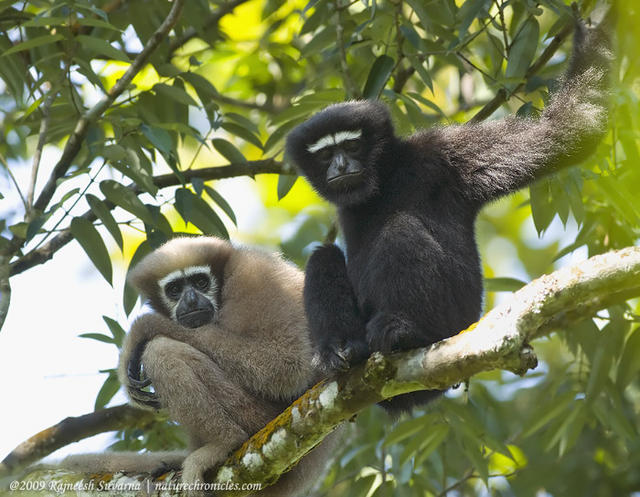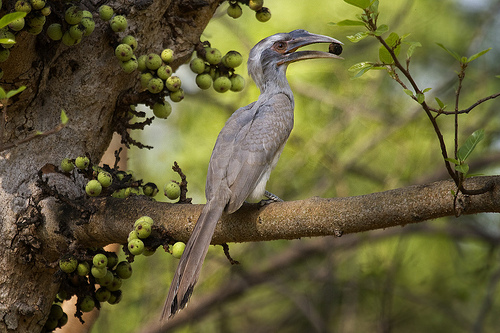 India’s biodiversity is home to a varied number of plant and animal species. From the Asiatic Lions inhabiting the semi deciduous forests of western India to the royal Bengal Tigers of Sunderbans, the country has a flora and fauna treasure that is as diverse as the nation itself. But while monkeys and langurs are a common enough site in many Indian states, their cousins, the great man-like apes namely gorillas and orangutans are not found in India. The only tribe of apes inhabiting the country is the Hoolock Gibbons, found in the North-east forests. And because it is the only one, the ape is unquestionably a precious jewel of the Indian forest.
India’s biodiversity is home to a varied number of plant and animal species. From the Asiatic Lions inhabiting the semi deciduous forests of western India to the royal Bengal Tigers of Sunderbans, the country has a flora and fauna treasure that is as diverse as the nation itself. But while monkeys and langurs are a common enough site in many Indian states, their cousins, the great man-like apes namely gorillas and orangutans are not found in India. The only tribe of apes inhabiting the country is the Hoolock Gibbons, found in the North-east forests. And because it is the only one, the ape is unquestionably a precious jewel of the Indian forest.
Where in India
Two species of Hoolock gibbons, Eastern Hoolock gibbon (Hoolock leuconedys) and Western Hoolock gibbon (Hoolock hoolock) have been reported to occur in India. They are found in Assam and the low-end forests of eastern Brahmaputra. They are also found in Nagaland.
Arm’s Length
Like all apes, the Hoolock Gibbons are distinctive in the great development of the arms, which are much longer than the legs. They also do not possess any tail. The long arms are actually more than double the length of its legs and are a key balancing organ without the tail associated with arboreal monkeys.
 Coat Colour
Coat Colour
A new born gibbon is covered with yellow tinted greyish white hair, but adults are black. Female adults coat colour fades to a yellowish grey. They are also sometimes called the white browed gibbons because of the white color tuft above the eyes.
Call of the Wild
Gibbons are known most for their shrill calls. With the first rays of the sun, the family consisting of a group of 6-7 members starts jumping from tree to tree. It is then that one member, usually the father starts calling – a loud howl reverberating in the depths of the jungle. This is followed by calls of the other members of the family, chitchatting and progressing through the tree tops. It is believed that the name Hoolock too is is derived from the Assamese or Hindi word ‘ulluck’ meaning the loud call or howl of the gibbon.
In Nagaland and Assam there was once a time when people calculated the time of the day according to the howls and hooting of the Gibbons. With the morning calls, the farmers knew it was time to go to their fields. In the afternoon when the female gibbon would make a great call which was followed by the male, people knew it was time for lunch.
Forest Acrobats
It is said that gibbons rarely put their feet on the ground, spending most of their day on the top most branches of the trees, swinging effortlessly through the forest using its long arms. The mode of locomotion is known as brachiation. They are capable of leaping long distances through the air from branch to branch or running atop the leaves in the treetops.
 Fruit Lovers
Fruit Lovers
The primary food of these apes are fruits, seeds, flowers and sometimes insects. They pick the fruits with the help of their feet. Since, the gibbon’s diet is primarily on fruits, they play an important role in the forest ecology by acting as a seed disperser in the forest as the seeds are passed undigested, in a new location.
Losing Habitat
Today much of the gibbon population had been decimated and only few surviving groups are restricted to the mountainous primary forest regions straddling the boundaries.
Hoolocks love hill forest but now neither the hills remain nor do the forests owing to mining, roads, infrastructure development and industrial presence.
Poaching os one big threat to these apes as their body parts are used as traditional medicines. Their tree-top dwelling habits are no match to complicated firearms that are killing and destructing the species.
Ironically, the existing population is very small and therefore, with poaching and habitat problems, the rapid depletion and extinction of the species is a grim reality.
Related Stories:
Interesting Facts About the Indian Elephant
Leopards: Victims of the Man-animal Conflict
Rainforest Festival to Highlight Biodiversity of Eastern RainForests
Reference: Nagalandpost










Is there anything better than a hollow of gibbon on a quite misty morning !!
No alarm clock can even come close to that one experience…of being woken up by nature herself..:)
I hope our next generation can enjoy the beauty of nature and see these wildlife just like us.
Let’s keep our fingers crossed Nikhil..
Hoolock gibbons are found not only in assam and nagaland , it is found in arunachal also. Infact its the state animal of arunachal pradesh.